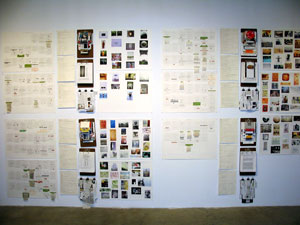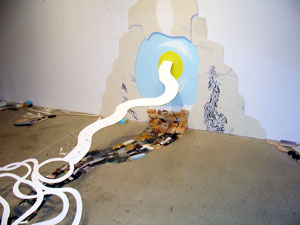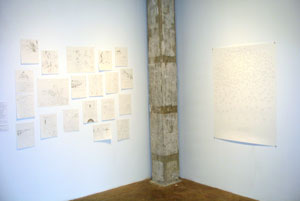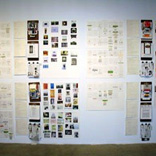The work of Beth Campbell, Danica Phelps, and Eric Schnell currently on exhibit at Arthouse offers three approaches to navigating the clutter of everyday experience. All three artists reshape the details of daily life to reveal both its patterns and its random moments.
Beth Campbell’s My Potential Future Based on Current Circumstances is a flow chart of the possible outcomes of fairly banal actions. The New York-based artist doggedly works out the consequences of the smallest choices, from buying and using a new toothpaste to agreeing to appear in her alumni magazine, and charts the hypothetical outcomes with calm ambivalence. In constructing this possible biography-to-be, Campbell considers a wide range of outcomes, some earthshaking, many less so, and ends up demonstrating the proximity of the banal to the exceptional. In the video Same As Me, the artist also scrutinizes the individual acts that make up a regular day — sleeping, eating, waiting — showing us three possible iterations of those acts. Campbell appears as three different versions of herself and moves through the same routine in different places, perhaps as the outcome of different choices made (or maybe that’s just the influence of Campbell’s Potential Futures hanging nearby).
The beautifully rendered storyboard-style preparatory drawings for the video are annotated with the specific amount of time an action or the motionless period between actions should last, measured in “counts.” Campbell’s drawings demonstrate the level of detail in her self-observation: she records the position of fingers, the placement of strands of hair, and other small gestures that, in the end, were crucial in the construction of the video’s narrative. As a result of seeing these steps laid out, it’s tempting to get stuck on the technical aspects of the work. How did she get the pacing right? How can the points of view always look so much the same? What kinds of things did she fix in the editing stage? But just as the sketches reveal the process behind the piece, they make that process part of the work. They emphasize the artificiality of the project, and frame the video as a representation of multiple hypothetical futures.
Tracking cash flow is a brutal way to monitor one’s daily routine. In her large paper scroll Providence, Brooklyn-based Danica Phelps records her income and expenditures and maps them out in tiny script. The tone of the resulting narrative is generally impassive, but the little abbreviated drawings that punctuate the story are crammed full of vitality: the groceries she bought, the champagne she splurged on. Phelps’ drawing is so fluid that it seems intuitive or automatic, even in these miniature pictures. Where this really comes to the fore, though, is in the fragment of Integrating Sex Into Everyday Life hung on the opposite wall. These pictures, some of which are mounted on wood, some pinned directly to the wall, are also indexed according to Phelps’ daily accounting system. The value of each work, and, in some cases, the purchase price (including the cut that went to the artist) are recorded on the objects. As in Providence, these drawings are bright spots on Phelps’ otherwise fairly dry conceptual framework. They are proof of beauty in the mundane, and in a few cases they transcend it altogether. Her images of lovemaking suggest that even these perfect moments can be, should be, commonplace, and that the rest of daily life could be beautiful like this as well.
Phelps’ drawings help make sense of her exhaustive catalog of her daily routine. Without that necessarily personal aspect, the project falters; it’s the apparently intimate insight into someone else’s life that makes the whole thing compelling. Artist, Collector, Curator, Spy, on the other hand, is a kind of retreat from that intimacy. The piece is an exhaustive record of, yes, her bookkeeping; but it also charts visits to what seems like every gallery in New York, and includes a partial photographic record of that reconnaissance mission. Here Phelps’ project threatens to become arbitrary and boringly obsessive, following a rigid purpose instead of the chance occurrences that make up the other works.
Where Phelps and Campbell represent the past and future of discrete moments in life, the work of Galveston-based Eric Schnell is constructed from the physical remnants of experience itself. In the large front gallery, Schnell constructed a swirling eddy of stuff ranging from scraps of wood, wire, and photographs, to plastic and sand. The carefully arranged debris, which unfolds from a wall drawing onto the floor, wavers between raw material and waste. Maybe the distinction is unnecessary. The implication seems to be that life processes are cyclical, in other words, that we make new things from trash.
The series of five framed drawings, Drawing Sequence 1-5 (Rainbow Claws) (2004), mounted on one wall, seem starkly separate from the rest of the work. On their own, the pictures are tightly drawn and tense, and yet still full of dreamy anxiety, with a repeating figure who looks stuck in uncontrollable situations. But their relationship to the rest of the installation is vague. Perhaps it’s the proximity of Campbell’s and Phelps’ work that makes disjunctions like this and the overall lack of cohesion in Schnell’s installation appear more problematic. The disparate pieces need a touchstone somewhere to confirm that the whole thing is intentional. This is nearly accomplished by two things that rise out of the drifts of stuff in Schnell’s work. One, in the center of the work, is an animation tracing the metamorphosis of ghostly insect- and plant-like bodies that grow, shift, and decay. The plantlike forms in this video are picked up on a narrow wall nearby in a single, very fine drawing of a foliate motif. This wall drawing merges into a tangle of wire. It and the video move towards providing a common structure for the work because they both thematize the transition between drawing and object, between ideal forms and material reality. They also reinforce the organic theme that is latent in the rest of the installation, but which is overpowered by the harshly inorganic bits and pieces Schnell works with.
The seductive thing about all of this work is that what it communicates seems so open and authentic, as if we had a window into these artists’ life experiences. But it’s dangerous to collapse represented life and real life. Campbell guards against this kind of conflation by the very planned, rigid structure she lays out for us. Schnell hides the “real” parts of his work behind a monumental abstraction. Next to these two, Phelps’ work looks more straightforward, but there too we’re not seeing a complete record, and that would be beside the point anyway. Regine Basha’s juxtaposition of these three artists’ work is incredibly evocative. The pieces play off one another, and together they create an elegant scrutiny of daily existence.
Images courtesy the artists and Arthouse.
Heather Mathews is an art historian living in Austin.






